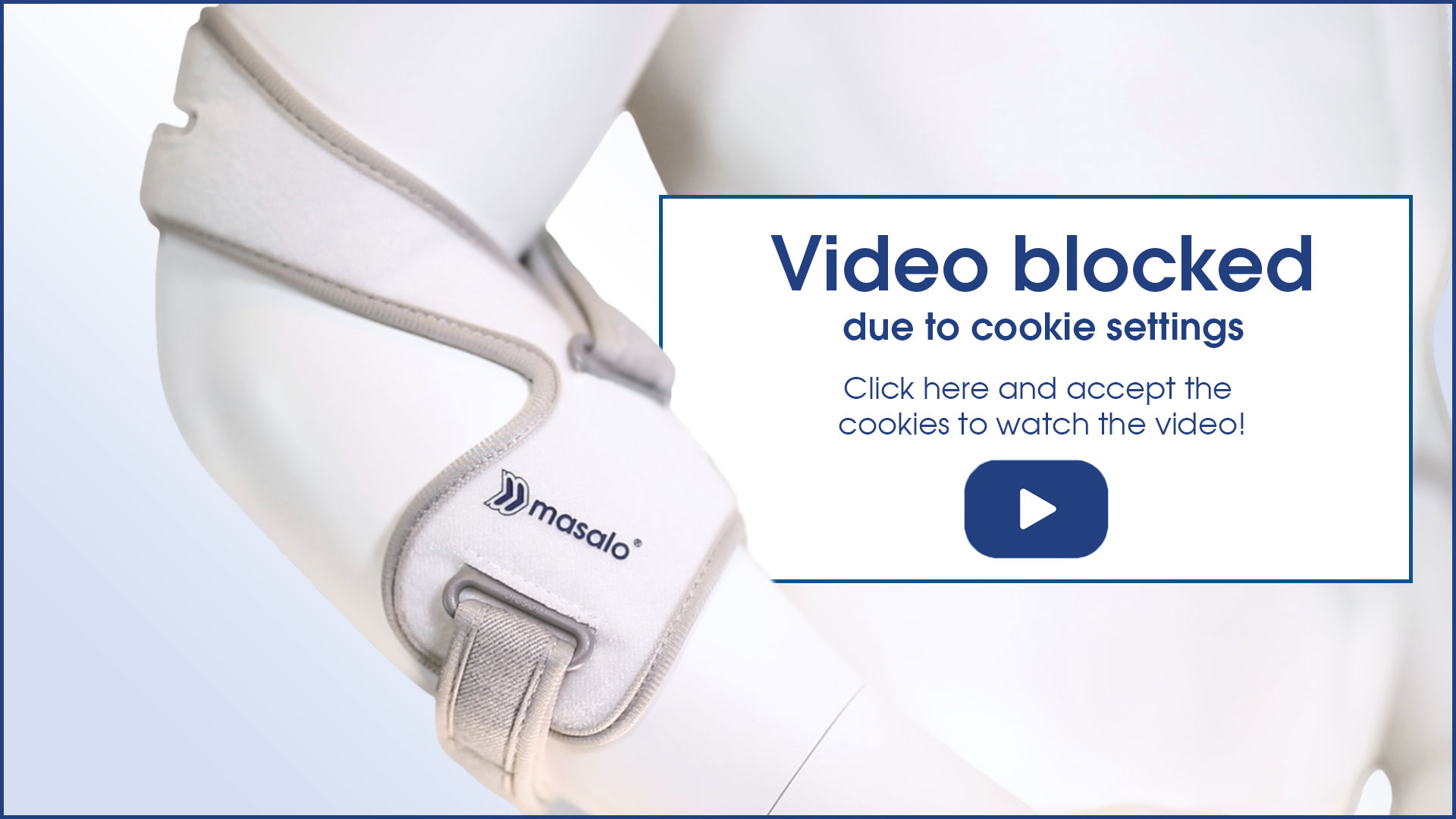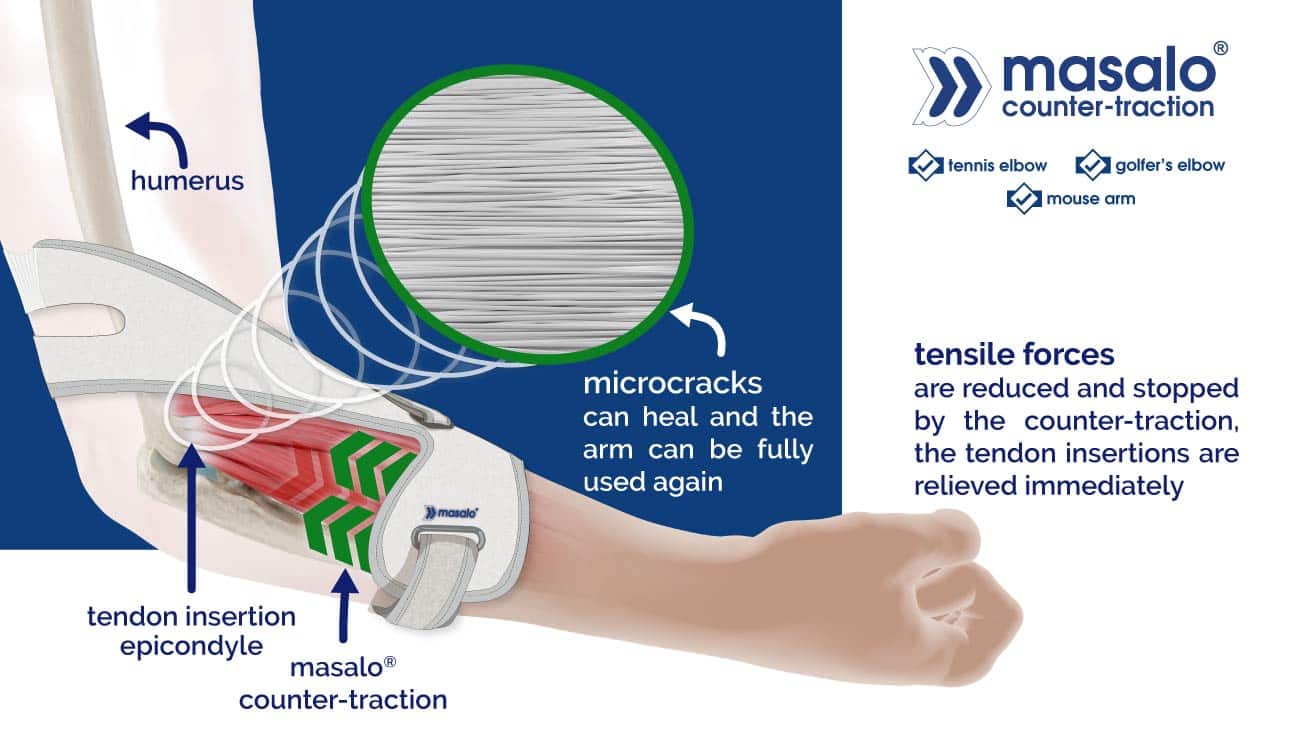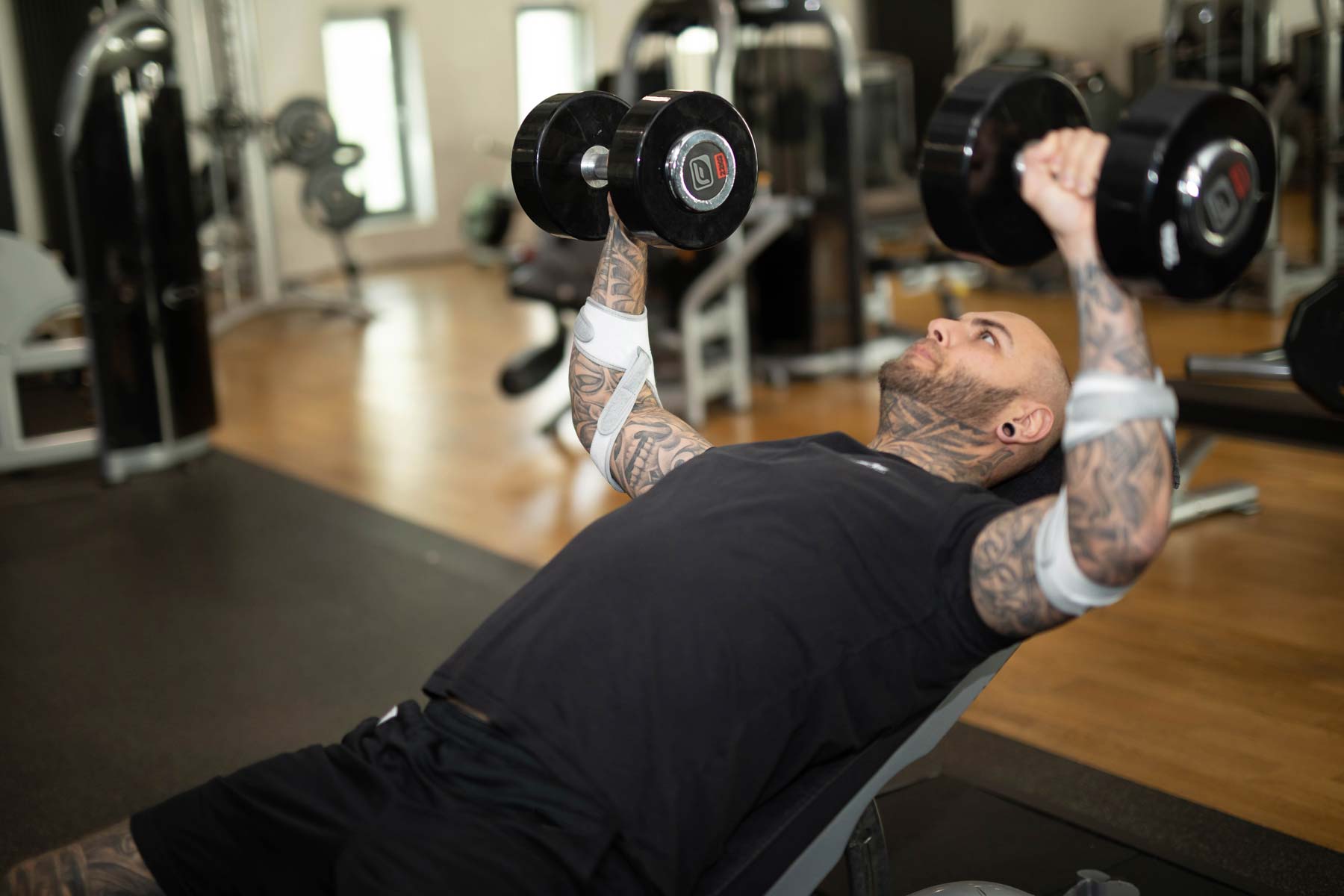On this page you will learn everything about epicondylitis and how to quickly and safely resume your favorite sport despite the treacherous injury.
Short menu / Topic overview
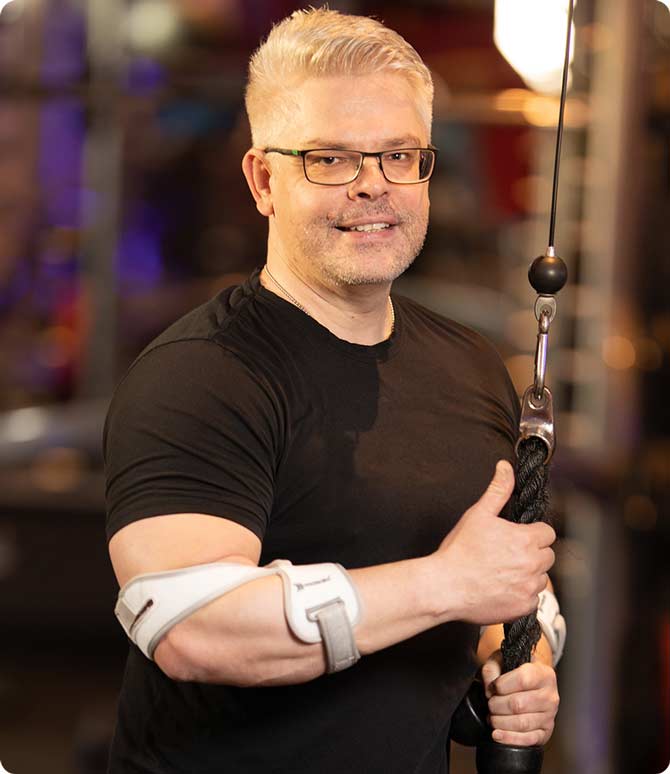
Epicondylitis – emergence and information
The Epicondylitis, better known as tennis elbow or golfer’s elbow, is widespread in all areas of sport, especially in weight training and sports with additional arm or hand strain (weights, sticks, clubs, etc.) epicondylitis is almost a constant, uninvited companion.
This injury to the tendon insertions of the forearm is caused by tensile forces that act with every movement of the arm. Overloading can cause microcracks, which can then become inflamed and cause severe pain.
Repetitive stress and repetitive motions then add to the injury and correspondingly the pain in the elbow area.
Due to the repetitive exercises – i.e. several repetitions, several sets – that are consciously carried out during weight training, for example, and the minor overloads (muscle soreness) that are also often consciously accepted, lead to a strong spread of tennis and golfer’s arm in the weight training and fitness sector.
Especially in bodybuilding or weightlifting, the stresses are of course particularly great, as the high weights exert enormous forces on the muscles and tendons.
The name tennis elbow or golfer’s elbow depends on which muscle part and which tendon insertion is affected.
For the outer tendon, the radial epicondyle, the common name is tennis elbow; for the inner tendon, the medial epicondyle, the term used is golfer’s elbow or golf elbow. Due to the widespread nature of the injury in both sports, these terms have become colloquially accepted as the common name for epicondylopathy.
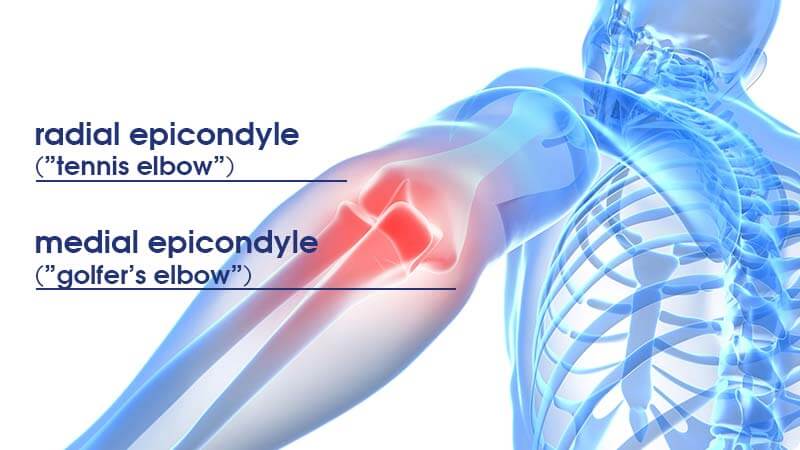
Diagram: Tennis elbow and golfer’s elbow
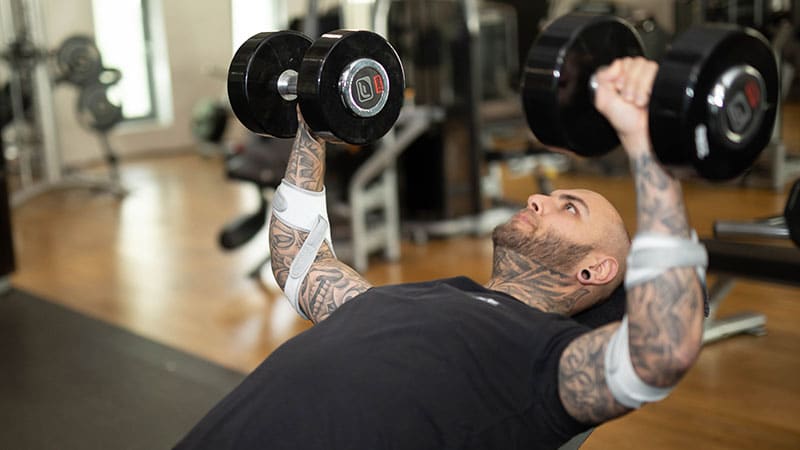
Weight lifting can be resumed quickly with the Masalo Cuff
Tennis elbow in weight training & bodybuilding
Often, epicondylitis, when it occurs on the outside of the forearm, is triggered by biceps curls or similar exercises. Especially when performing the exercise with a straight barbell bar, the angle for the tendons is relatively unfavorable, the tensile forces are particularly strong, and this can favor the emergence and development of the injury.
But not in every case the cause of tennis elbow is due to sports. Even simple work at home, at work or at the PC can trigger epicondylitis, and strength training then often promotes it.
The pain is often particularly severe with loads for the biceps, exercises such as bench press, chest press, etc. – generally with exercises where the main load takes place during the extension phase of the arm or must be countered due to high weights.
Golfer’s elbow in weight training & bodybuilding
If the injury occurs on the inside of the forearm, you have contracted what is known as golfer’s elbow.
This is mainly triggered by exercises that place a heavy load on the inner side or exert strong traction, which can be, for example, triceps exercises with oblique grips on the pull tower, lat pulldowns, pull-ups and also butterfly.
Again, however, there is no standard trigger for the injury, the development of the epicondylitis can have a wide variety of reasons.
Diagnosis:
Please have any elbow or elbow joint pain diagnosed by medical professionals only. The information on our pages cannot replace them.
If you have been diagnosed with tennis elbow or golfer’s elbow, we would like to introduce you to our product, which can also provide you with freedom from pain and unhindered enjoyment of sports again, regardless of whether you are a bodybuilder or weightlifter, or strength training in the gym or at home is simply part of your well-being.
Exercising with the Masalo Cuff
Once the tensile forces of the forearm muscles are intercepted or redirected by a counter-traction system, shouldn’t that clearly support the healing process and relieve or eliminate the pain?
This is exactly what the Masalo Cuff does. The counter-traction system provides immediate and lasting relief to the affected area. The tendons are spared, the pain is relieved and healing is positively supported – although the arm is still used. The unique design of the Masalo Cuff allows it to be worn 24 hours a day, day and night.
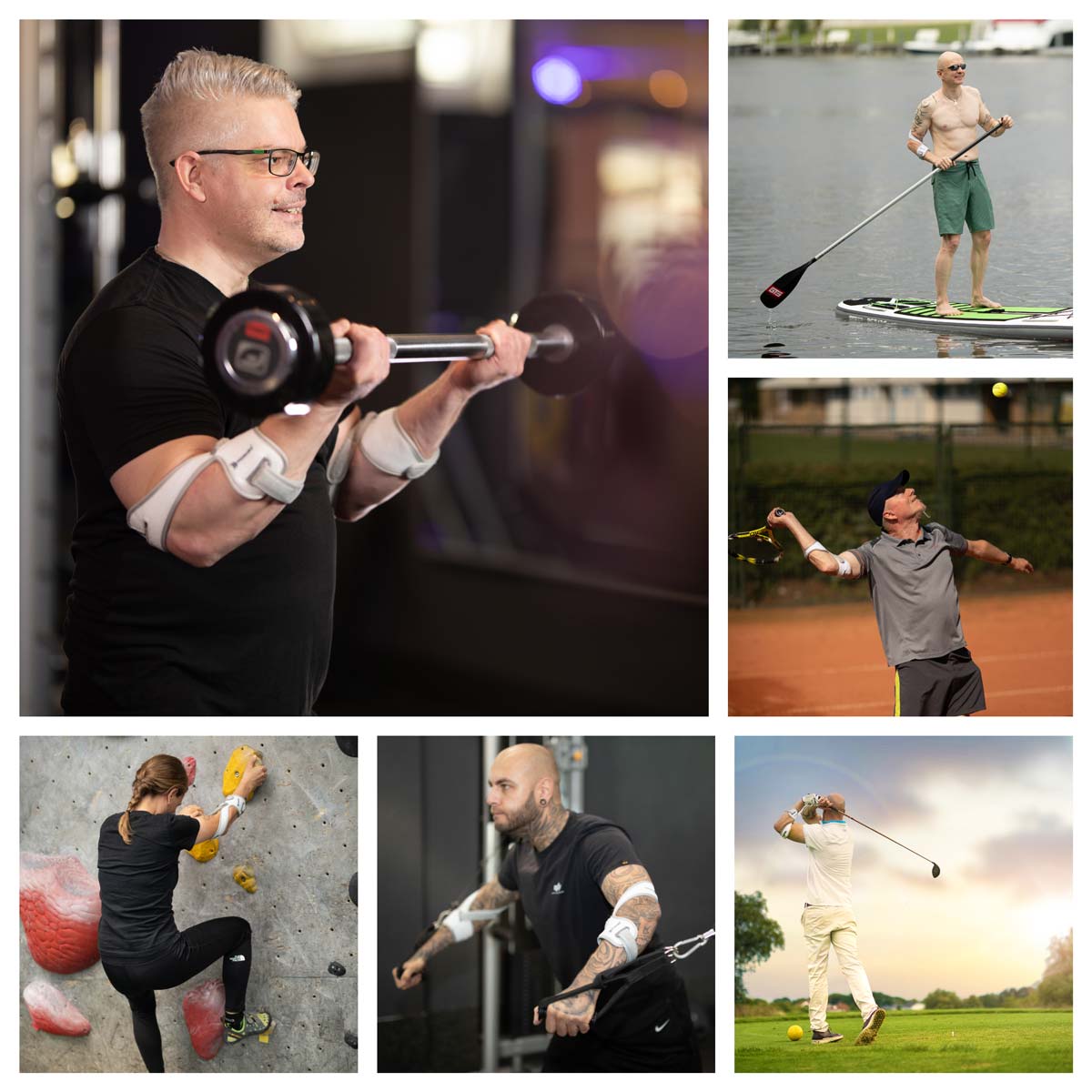
When playing tennis, the experience of other customers has shown that the racket posture is improved. The stabilization of the elbow leads to a higher impact force. For example, sufferers with the cuff have benefited in other sports such as javelin throwing, handball and volleyball.
In golf, the Masalo Cuff acts as a guide for the golf swing and can improve your handicap.
Strength training can also usually be resumed quickly, without long periods of downtime. But also preventively, especially in the preparation for competitions for bodybuilders and competitive athletes, the cuff ensures constant performance and drastically reduces the susceptibility to injury of the tendons despite the great loads.
Extreme sport thanks to the Masalo Cuff
Even extreme sports such as mountaineering etc. are possible with the Masalo Cuff without any problems. Garvin Außenegg proves this with an impressive video.
Without the cuffs, the pain from his golfer’s arms was unbearable. After putting on the bandages, he went straight to the summit!
Enjoy the beauty of nature in fantastic images!
Please support the Youtube Channel of Dr. Garvin Aussenegg
How does the Masalo Cuff work?
The Masalo Cuff MED works with the proven Masalo counter-traction principle, which is still unique in the field of epicondylitis aids.
More than 70,000 customers have already been able to overcome their injuries with the help of our Masalo Cuff and return to their sport with renewed vigor.
The arm remains fully mobile even with the cuff attached.
The upper arm strap is then also attached with Velcro and adjusted according to the activity and load.
Due to the unique and patented design, the upper arm strap holds with every movement. Slippage of the belt is prevented by an additional element with silicone nubs inside (this can optionally also be easily removed). The tensile forces are reduced or stopped completely by the proven counter-tension principle, and the affected area is relieved. The negative tensile forces are diverted to the upper arm strap.
This gives the affected tendons a chance to heal, although the arm can still be used and loaded.
You can find more details about the function and the operating principle here:
Common methods of treatment and alternative therapy for epicondylitis
Prolonged immobilization of the arm is usually not an option for ambitious bodybuilders, fitness enthusiasts or weightlifters; life is too heavily tailored to sports.
In addition, immobilization can ultimately cause the tendons to lose elasticity due to non-use and the injury can then reoccur all the more quickly after a later resumption of training.
“Normal” tennis braces, orthotics or claps always work with pressure/compression on the muscle bellies and thus use a completely different approach to action.
The Masalo Cuff does not work with compression, but with the unique counter-traction principle and can therefore be worn permanently.
The secured blood circulation can positively support the healing process, even at night the arm is supported and relieved.
Tips for strength training
When you use our Masalo Cuff and have decided to keep it, we recommend the following things to ensure a quick resumption of training and a speedy recovery:
- If your cuff fits well, you feel the countertraction/relief, and you can resume your daily routine normally, there is no reason why you should not resume training. However, we recommend that you refrain from fully extending the arm in the beginning and start your training with light weights and exercises.
- In the gym, for example, prefer to use less weight and perform more repetitions.
- When exercising, do not work with momentum, but perform the repetitions extremely slowly and cleanly, be sure to allow 4-5 seconds per way. This results in intense training and maximum stress on the muscles, but minimal stress on the injured tendon insertions.
- Once you have conquered your epicondylitis, continue to exercise with the Masalo Cuff to prevent possible relapses and to continue to relieve the affected area. Many of our sports customers often even use a secondary cuff for their training and wear it well beyond the actual injury period.
- When you are fully recovered, use common stretching exercises for the body and arm. This can increase the elasticity of the tendons and reduce the possibility of recurrence of the injury.
- However, DO NOT stretch your arm if you still have acute pain. Since this represents a renewed overload and overstimulation of the tendon insertions, it may even significantly aggravate the pain and the injury.
Nutrition and dietary supplements
A healthy diet and supplements can also help strengthen tendons, muscles and joints, reducing the risk of injury recurrence later in life.
Together with the Masalo Cuff, epicondylitis can thus be effectively combated and also prevented.
But be sure to get professional advice on this!
Summary tips for epicondylitis:
- Correctly applied Masalo Cuff
- Clean training (personal training)
- Adjusted weights
- Load control
- Healthy diet
- Useful dietary supplement
ORDER NOW!
Order 100% safe and convenient in our online store!
Free shipping within Germany!
 Watch TV reports!
Watch TV reports! shop@masalo.eu
shop@masalo.eu +49 (0) 4131 - 727 15 97
+49 (0) 4131 - 727 15 97
